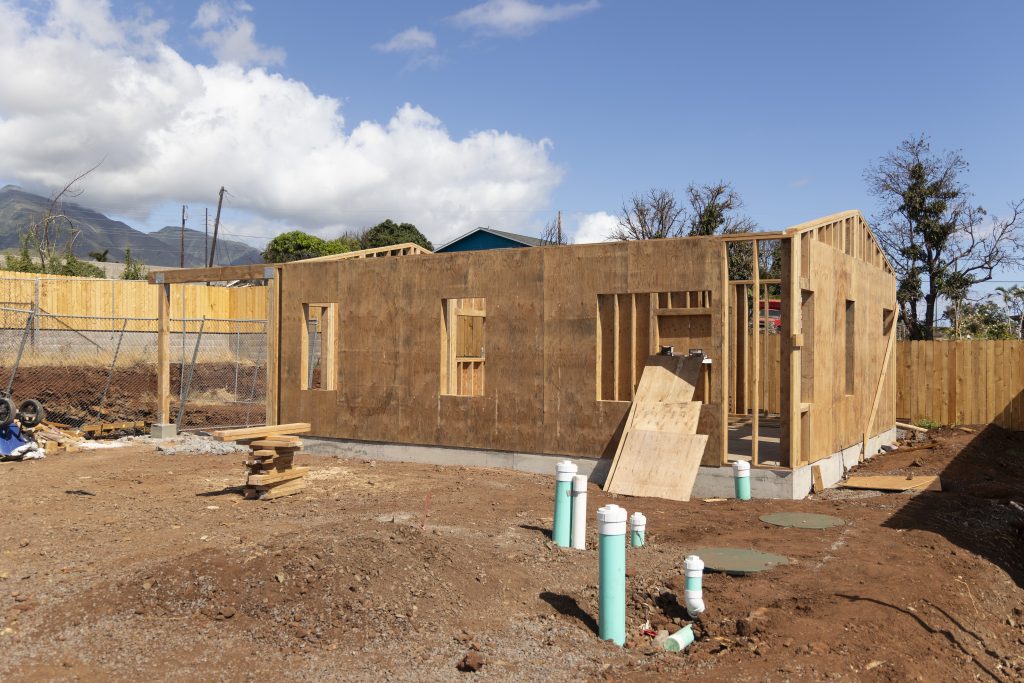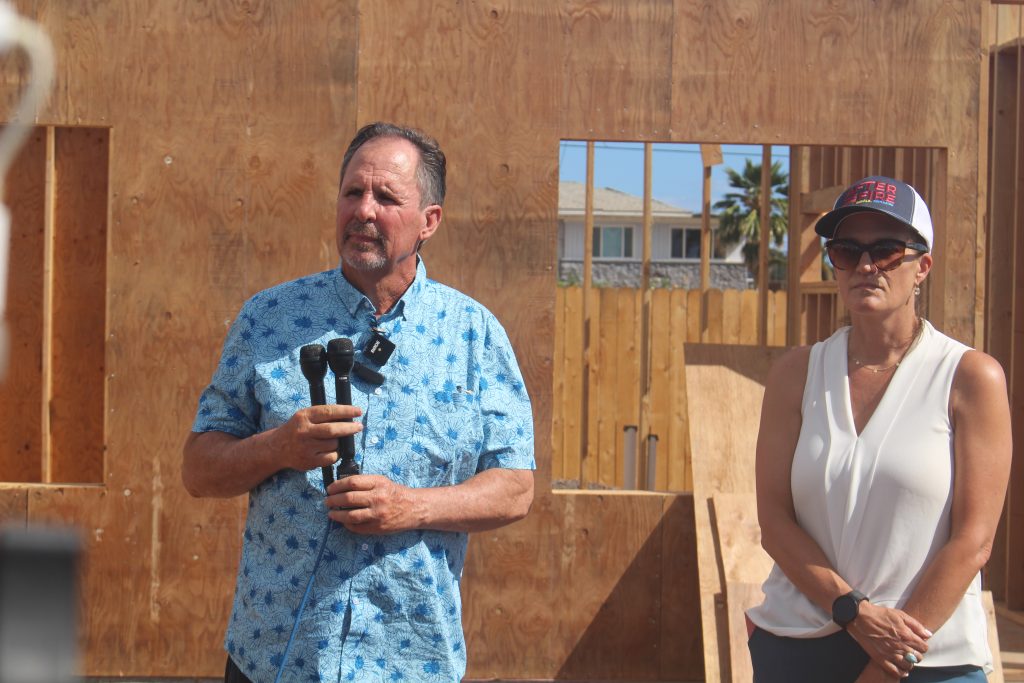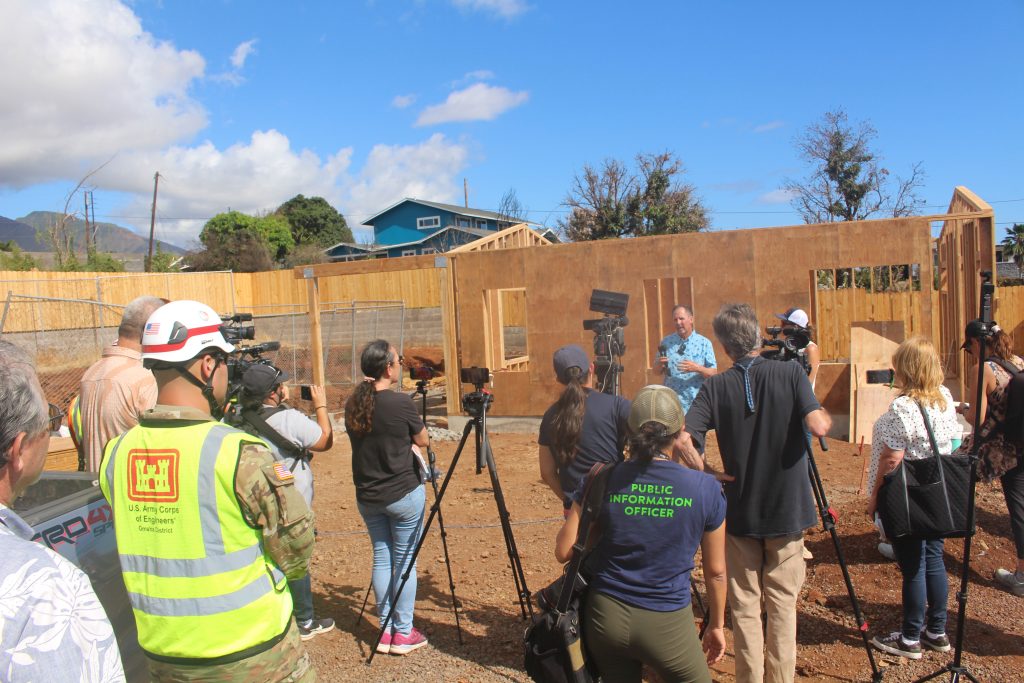First home rebuild in Lahaina impact zone gets walls and foundation
Rising from the ashes: building walls and a foundation
Walls are now in place for the first home to be rebuilt in the Lahaina impact zone since the deadly August 2023 wildfires. It’s a visual reminder of the hope that exists among those wanting to return to their beloved neighborhoods, and an encouraging sign of progress as displaced residents work their way through the permitting and construction process.
“I was in complete denial that the fire would ever get to my home,” said Gene Milne who was in the process of building his home on Malanai Street when the Aug. 8 fire tore through the neighborhood, killing at least 102 people and destroying much of Lahaina Town.
Milne was evacuated at around 8 p.m. on Aug. 8, and waited at Wahikuli Wayside Park with hopes of returning to his home when the smoke had cleared, but when he finally gained access a couple of days later, what he found was complete loss. “It was devastating to us… we had hearty siding… it was as fireproof as it could possibly be,” said Milne of his home, which was 70% complete with a finished ʻohana unit that he had been living in for almost a year.
“We were taken in by some neighbors, some friends, for a couple of weeks. Then we moved back to my mother’s place out in Henderson, Nevada,” said Milne, who spent the last 10 months on the mainland, where his wife remains until more of the rebuild is complete.
While Milne was walking on solid ground Wednesday, there were times in the last several months that he felt discouraged and almost pulled the plug on his rebuild.
“One of the biggest [problems] was we ran into some issues with our soil testing, and we didn’t have a lot of answers. That was really disturbing. It was hard emotionally to deal with. We got to the point where we almost said ‘no,’ and started looking for houses. Eventually my wife and I just said, ‘okay, if we don’t know by this date, then we’ll make a decision,'” he said.
At one point Milne called his old relator to weigh his options and determine what the process would be if he decided to sell the property. “He was very adamant,” Milne said of his realtor. “He didn’t even want to touch any of the cases because the negative, connotation to go with it, so it never really was a serious thought.”
A recent study by the nonprofit Hawai‘i Land Trust (HILT) and Kahālāwai Consulting LLC studied the threat of accelerated land loss by local families and businesses. It noted that despite new regulation and a significant outpouring of public and private aid to counter immediate displacement, the Lahaina disaster may lead to increased real estate sales and accelerated land loss in the years to come.
Milne said the rebuild has been healing for him. “I’m not a person that sits still very well,” he said. “Really from right after the fire, I was on top of trying to get my permits.”
“Just sitting there was troublesome. It was difficult emotionally to deal with, even with all the support, it still was very challenging. So getting on site for me is the biggest healing effect that I have. Because I know that I’m moving forward now and then I can see, even though it’s a long way, I can see the end. I’ve done it before so I can see it, and it feels very good,” said Milne.
onSince permits were still open on his property, the process towards rebuilding was smoother than starting from scratch. “The ʻohana was so new that they basically did a quick review, and within three days, I had my permits. It was fantastic. It got me started… and, we’ve just been going gangbusters ever since,” said Milne.
Milne said he’s putting his own sweat equity into the rebuild with 95% of the project being done on his own. “I’m just out here every day, getting done what I can, being creative about how to get beams hung up or things like that… [I’m] just hanging out by myself. Obviously things like the plumbing and electrical and slab work, I have to have someone else do.”
Inflation is a factor that property owners must face as they look for economical ways to stay in Lahaina.
“You know, things are a lot more expensive than they were the first time around, so you have to deal with that… I’m using my insurance money to rebuild with, so I’m not paying any interest… but, it’s a challenge. For me, I’m very lucky that my house was new, so it was insured for a proper value. I imagine many people that have gone through the last couple of years that have not increased their insurance, that it could be a much bigger problem for them,” said Milne.
He said people in his neighborhood are trying to help each other out by sharing contractor information and first hand accounts of businesses that do a good job for a reasonable price.
“Hopefully within about… six or seven months… I’ll have the ʻohana finished up. My wife and I will be able to move into that… and then I’ll get started on the main home,” said Milen who is looking forward to the day his wife will join him in mid-August. I’m looking forward to that day where I can have a cocktail on the lānai and enjoy Maui—home.”
One-year mark nears: Mayor focuses on funding, transition to permanency
As the one-year mark nears since the August 2023 wildfires, Maui Mayor Richard Bissen said the focus in the coming weeks will be on securing funds as Maui transitions away from temporary housing to permanent rebuilding.
“I feel very grateful. So very humbled by all the work that’s gone into this so far,” said Bissen, who joined local media in a visit to the impact zone on Wednesday. “As you’ve seen throughout the day. It’s taken a team effort from search and rescue, debris cleanup, hazardous material cleanup, residential, commercial… there’s so much going on.”
He pointed to Milne’s Wahikuli residence saying, “This is one of the visuals, a milestone, which is the first of its kind, the first building that’s this far along… I think it shows the progress, but more of the hope that our people can see that they, too, can get to this point, once they’ve gotten their lands cleared and the land is safe to return, to come to us, get that permit… I think what’s going to impact most people is their ability financially to be able to rebuild.”
He said, whatever the government can do to try to help with that, is his next focus.
“What I’m going to be focusing on is asking the federal government to get us our Community Development Block Grant disaster relief funds. That was a big reason I was in Washington, D.C. last week was to get all of our partners, our federal family, together to say we need these funds to help us with the permanent build. We’re at that point where we’re getting ready to want to rebuild permanently. I think everyone understands FEMA is temporary help—and it’s been incredible; but we’re ready to transition to the permanent site. So the focus right now is on getting CDBG funds through Congress,” said Bissen.
Mayor Bissen said he wants people to call and ask us for help if they need it.
“I want us to be able to provide case managers for our folks as they go through this process… I know every situation is different. We want people to know not to give up hope—that we are doing everything we can, just as much as we can, to help get them back to their properties,” said Bissen.
Despite plans to rebuild an identical lot, ‘This neighborhood will never be the same’
Kim Ball, Hi Tech Surf Sports owner and a member of the Mayor’s Lahaina Advisory Team is eagerly awaiting the next step in his rebuilding process on Komo Mai Street. Ball was working in Central Maui after the fire and learned that his home was lost from his son Cody, who hiked in from Kā’anapali to survey the damage and learned his home on Aki Street was also destroyed.
“I think I was in shock for a couple of days,” Ball said. But his despair turned toward action in the days, weeks and months that followed.
“I’m in my 70s. I want to see it rebuilt in my lifetime,” Ball said.
Since his home was only five years old before it was destroyed in the August 2023 wildfires, Ball said he knew his contractor would still have his plans, and that’s where he began.
“Actually, the contractor—he was a skate kid who used to work for us in the 90s, at our shop. So, now he’s a really good contractor, and he built the house five years ago. He had the plans. He texted me right away saying, ‘We’re there for you.’ So that gave me good peace of mind the whole time.” he said.
Ball tells Maui Now he plans rebuild the exact same home. Although the footprint for his home will be identical, the area around him will likely be different due to life changing moves some neighbors had to make in the aftermath of the fire.
“The only sadness I have is that this neighborhood will never be the same… This is the best neighborhood in my mind… I lived in Lahaina for 44 years. This is the best neighborhood in Lahaina. And to hear [that] my neighbors, some of them have moved off—moved to the mainland, moved off island, bought different property in other places on Maui—they’re not going to come back,” said Ball, noting that many thought the process would take much longer.
According to Ball, all 67 homes in the neighborhood were locally owned and were owner-occupied. His home is among at least four in the neighborhood that have cleared their lots and are moving forward with next steps.
“I think the thing is, you know, for the rebuild, you have to have all your t’s crossed and iʻs dotted,” said Ball. Having architectural plans, an electrical engineer and the right contractor have all helped to make the process a smooth one for him.
The permitting process for Ball took 15 days. “I mean, I’m amazed that, you know, we’re 10 months out and I didn’t think we’d be this far along.”
Ball plans to stay at a temporary cottage while his home is under construction. Contractors have estimated the move in date would likely be in a year.
“My wife is sleeping better now, knowing it is maybe going to be a year. We have a place for a year because there’s nothing worse than being on pins and needles. Where are you going to move? Where are you going to be? We moved three times before we got to the place right now,” he said.
As for his business, Ball has five skate shops on the island, including one at the Westin in Kāʻanapali. The West Maui location was closed for two months after the fire. “We reopened two months later and [admittedly], it’s been pretty slow; but we wanted to get people back to work, and we want to get some normalcy with our company. Things have picked up the last few weeks, but it’s been tough business Island wide,” he said.
As a member of the mayor’s advisory team, Ball said that much of the focus to date has been on getting people out of hotels and into longer-term housing solutions. “Now it’s just trying to get people rebuilt, get back on their lots. They need a more stable, living situation,” he said.
With commercial cleanup now underway, the visual progress has been a positive sight for those close to the impact zone. Ball said he’s looking forward to getting the community swimming pool and parks back as the rebuild gets underway.
Mega fire recovery expert: Maui’s higher property values to impact the speed at which rebuilding occurs
Jennifer Gray Thompson, a nationally recognized subject matter expert (SME) in megafire recovery, has worked in 18 megafires in five states and is CEO of After the Fire USA, an organization created by wildfire survivors and experts to support communities as they recover from fires.
“We call this a mega fire because it has an outsize impact on the land and the people,” said Thompson during an interview from the impact zone, saying such fires burn much hotter and faster and are deadlier than others we’ve seen before. “A mega fire has an outsize impact because it burns really hot and it actually destroys the infrastructure under the ground. It’s not a house fire. It’s not an orderly wildfire. It’s like a Godzilla that actually trumps through a place and just does utter destruction. It’s often very hard for people to make sense of it in their minds when they are looking at the destruction after it.”
She described the Lahaina fire as the deadliest mega fire in the United States in over 100 years. “So not only was there a destruction of commercial property in the downtown [area] and the homes, but also a tremendous loss of life. And that’s something that really does complicate the recovery, as it should,” she said.
Thompson said she’s encouraged by the rate at which everyone has leaned in—from federal, state and local—to clean up and address infrastructure issues. She said it’s the first time she’s seen rebuilding happening at the same time as debris removal.
“So I caution people to look at any fire, but in particular this point and try to layer other fires over it. Exactly. There are some things that we know what to expect in the timeline, but there are other things, like the fact that this is the most remote place on Earth, and it’s an island that has incredibly high land values and relatively low incomes with respect to what people have to rebuild,” she said.
Thompson explained that the higher property values on Maui will impact the speed at which the rebuilding can happen.
“And even though I am a mega fire expert, I always know walking into a community that I need to know all the demographics, I need to know the land values, all of those things. The higher the land value, the faster the rebuild. It’s just a matter of numbers of the interest. Unfortunately, developers, (which you’ve been very good at sort of warding off the worst of that)… there’s always going to be a pressure to rebuild because of the extraordinarily high land values here and relatively low incomes,” said Thompson.
“We’ve never seen that before. But we still know that you will be rebuilt between year five and year six, probably at the most between year six and year seven, but primarily 90% [to] 95% rebuilt by then. there are other communities with very low land values, especially if it’s a community that had, like Paradise, low land values and a much older population, and they choose not to rebuild most of the time,” Thompson explained.
In this case, experts acknowledge that Maui is very special in that way, but it means it also requires special care. Thompson cautioned against pushing for expedited results when it comes to rebuilding.
“Faster is good because you do need those visual deliverables, but faster should also, always hold the values of the community at the center of it first, ” said Thompson. “I caution people from the mainland, if they come here and they want to participate in the rebuild that they bear, and that they keep all of the values of the people of Maui in mind first, and that they contribute to something that will also show the rest of the world what’s possible after mega fire.”
Thompson said Maui is on the “world stage” for climate resiliency, and how to rebuild back in a way so the area does not burn down the same way. “There are ways to do that. It’s going to be hard. None of it is simple. But if that can be planned for at the beginning with a vision and by really leveraging the care of the people who want to help this place rebuild, you can reduce that number dramatically; or you can make sure it’s passing to family members, because the number one goal is to get everybody home who lost their home, not new people,” she said.























